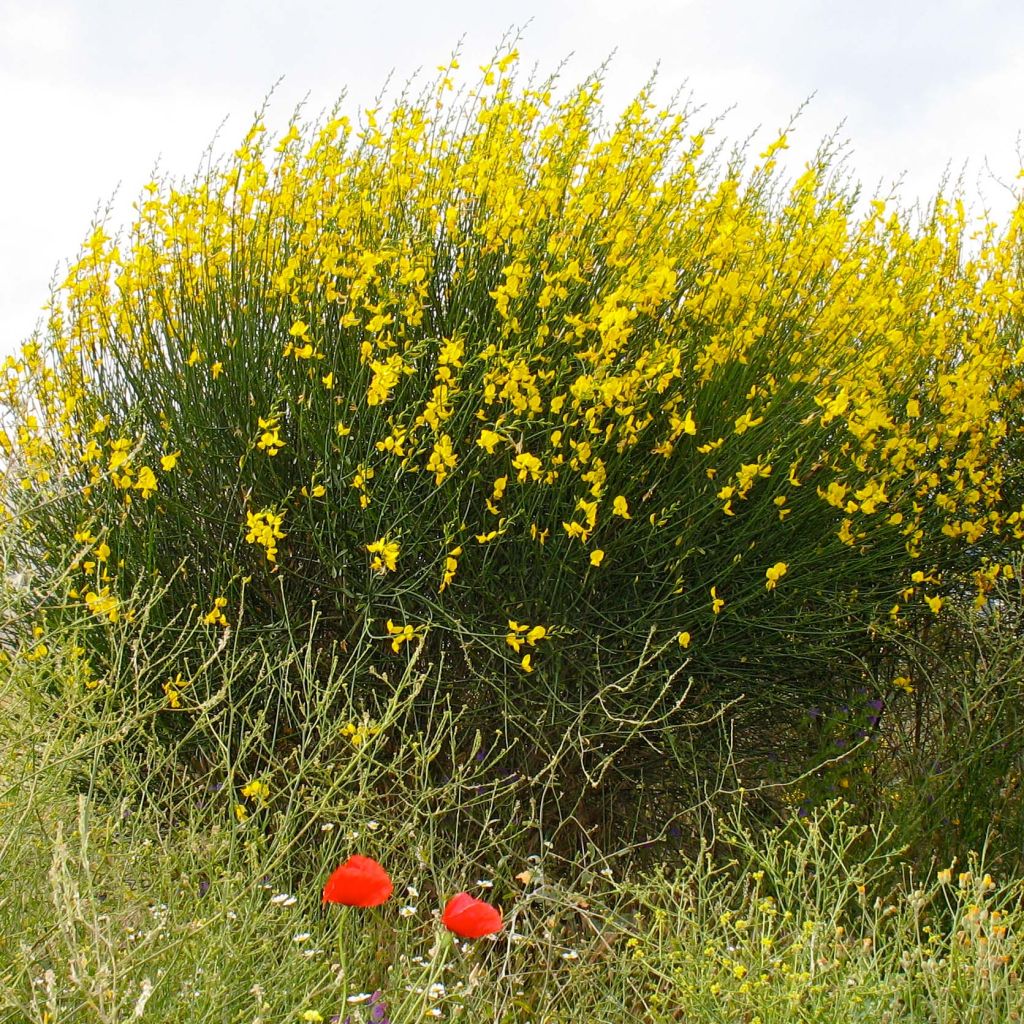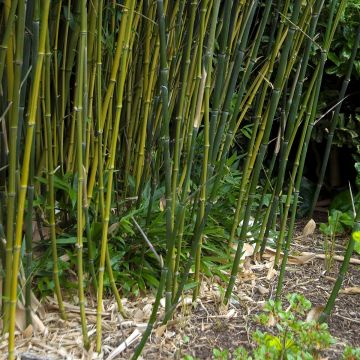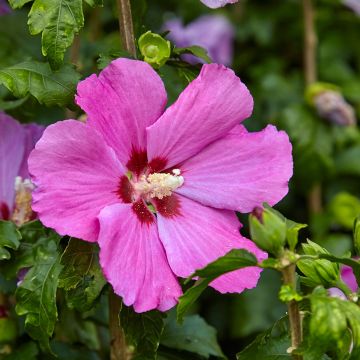

Spartium junceum


Spartium junceum


Spartium junceum


Spartium junceum


Spartium junceum


Spartium junceum


Spartium junceum
Spartium junceum
Spartium junceum
Spanish Broom
Planted in October 2021. I've already left a review but since then, this broom has become beautiful; its flowering is abundant and lasts a long time. It would easily exceed 2 meters but I prune it in September when the seed pods appear, so it stays in a nice compact shape. It has withstood all periods of drought as well as the intense winter frost and the extremely rainy summer of 2024.
Jocelyne , 12/11/2024
Special offer!
Receive a €20 voucher for any order over €90 (excluding delivery costs, credit notes, and plastic-free options)!
1- Add your favorite plants to your cart.
2- Once you have reached €90, confirm your order (you can even choose the delivery date!).
3- As soon as your order is shipped, you will receive an email containing your voucher code, valid for 3 months (90 days).
Your voucher is unique and can only be used once, for any order with a minimum value of €20, excluding delivery costs.
Can be combined with other current offers, non-divisible and non-refundable.
Home or relay delivery (depending on size and destination)
Schedule delivery date,
and select date in basket
This plant carries a 24 months recovery warranty
More information
We guarantee the quality of our plants for a full growing cycle, and will replace at our expense any plant that fails to recover under normal climatic and planting conditions.

Would this plant suit my garden?
Set up your Plantfit profile →
Description
Spanish Broom, Spartium junceum, is sometimes called the Rush Broom, due to its long, flexible, cylindrical branches that remain green almost all year round. This vigorous bush is not native to Spain, but to southern Europe, North Africa, and western Asia, where it is often considered invasive. It should be noted that where it thrives, in places where few plants can grow, it is almost indestructible! Not drought, frost, or poor soil can compromise its beautifully fragrant flowering, quite the opposite. It is an excellent plant for dry and rocky gardens or seaside areas, indifferent to the nature of the soil. Plant it in a large rock garden, bed, a hedge, or on a very sunny slope.
The Spartium junceum belongs to the large family of fabaceae. Like all brooms, it is a very hardy but short-lived bush, which readily self-seeds in rocky and poor soils. This species is found in arid and dry places, on acid or very limestone soils. The Spanish Broom is widespread throughout the Mediterranean region.
This broom, which can reach a height of over 2m (6ft 7in) and a width of 1.50m (4ft 11in), develops an erect and rounded habit, dense, but sparse-looking due to its small number of leaves. They fall as soon as the heat arrives, which indicates excellent adaptation to dry and warm climates. The flexible, arched, green stems bear simple, ovate-lanceolate, bright green leaves, hairy on the underside. In May-June, small clusters of pea-like flowers, 1cm (0.4in) in length, appear at the tips of the stems. They are a very bright, deep, warm, intense yellow, transforming the bush into a spectacular golden ball. These pea flowers are extremely fragrant, especially in hot and calm weather. Their intoxicating scent is sweet like honey, and can perfume an entire area of the garden and escape into a neighbouring garden. They are followed by the formation of fruits that develop into brown and then black pods that burst when ripe. It should be noted that the lifespan of this plant is quite short, around 10 to 12 years. Young Spartium junceum plants from self-sowings produce a powerful taproot that is difficult to remove once deeply anchored in the soil. This root does not like to be disturbed and makes the transplantation of mature plants quite difficult.
The Spanish Broom transports us to Mediterranean landscapes evoking a whole world of scents and colours and deserves to be seen and smelled in spring. It will fit in the corner of the house, or dominate a large slope with its size. It will contribute to the beauty of a large shrub bed serving as a focal point in the centre of a small garden. It can be associated with numerous shrubs with staggered foliage or flowering: dwarf conifers (Juniperus horizontalis, Abies balsamea Nana, white spruces...), a shrubby peony, a compact lilac (Syringa microphylla Superba), rosemary, an evergreen ceanothus whose blue flowering will echo its abundance of yellow flowers. Deciduous or evergreen small euonymus, shrubby salvias, and perennial geraniums create beautiful, low-maintenance flowering scenes in a wild garden. In a favourable climate, without irrigation, it will occupy a somewhat neglected large slope, with the Spanish Centranthus ruber, the Globularia alypum, the Erigeron karvinskianus, and the California Poppies.
A useful plant:
The flexible and resistant fibres of this bush were once used to make ropes and sturdy clothing. The essential oil of Spartium junceum, rare and precious, is mainly used in perfumery.
Report an error about the product description
Spartium junceum in pictures




Plant habit
Flowering
Foliage
Botanical data
Spartium
junceum
Fabaceae
Spanish Broom
Mediterranean
Planting and care
Saprtium junceum should be planted in spring or autumn in any well-drained, rocky or sandy, poor soil that does not retain moisture in winter. It is indifferent to the soil's pH, which can be acidic or even very chalky. However, it requires a very sunny exposure and dislikes heavy, clayey, suffocating soils. Choose its location carefully as it does not like to be moved. It does not require pruning unless you want to avoid self-sowing, which is frequent in light or rocky soil. Planted in poor soil, the plant has less tendency to become bare at the base and will flower abundantly. In case of severe winter, cut back the blackened stems at the base. Its lifespan is quite short, especially in fertile soil, around 10 to 12 years.
This bush has no specific diseases or enemies.
Propagation by sowing in autumn. Pour boiling water over the seeds, then let them soak overnight before sowing.
Planting period
Intended location
Care
-
, onOrder confirmed
Reply from on Promesse de fleurs
Similar products
Haven't found what you were looking for?
Hardiness is the lowest winter temperature a plant can endure without suffering serious damage or even dying. However, hardiness is affected by location (a sheltered area, such as a patio), protection (winter cover) and soil type (hardiness is improved by well-drained soil).

Photo Sharing Terms & Conditions
In order to encourage gardeners to interact and share their experiences, Promesse de fleurs offers various media enabling content to be uploaded onto its Site - in particular via the ‘Photo sharing’ module.
The User agrees to refrain from:
- Posting any content that is illegal, prejudicial, insulting, racist, inciteful to hatred, revisionist, contrary to public decency, that infringes on privacy or on the privacy rights of third parties, in particular the publicity rights of persons and goods, intellectual property rights, or the right to privacy.
- Submitting content on behalf of a third party;
- Impersonate the identity of a third party and/or publish any personal information about a third party;
In general, the User undertakes to refrain from any unethical behaviour.
All Content (in particular text, comments, files, images, photos, videos, creative works, etc.), which may be subject to property or intellectual property rights, image or other private rights, shall remain the property of the User, subject to the limited rights granted by the terms of the licence granted by Promesse de fleurs as stated below. Users are at liberty to publish or not to publish such Content on the Site, notably via the ‘Photo Sharing’ facility, and accept that this Content shall be made public and freely accessible, notably on the Internet.
Users further acknowledge, undertake to have ,and guarantee that they hold all necessary rights and permissions to publish such material on the Site, in particular with regard to the legislation in force pertaining to any privacy, property, intellectual property, image, or contractual rights, or rights of any other nature. By publishing such Content on the Site, Users acknowledge accepting full liability as publishers of the Content within the meaning of the law, and grant Promesse de fleurs, free of charge, an inclusive, worldwide licence for the said Content for the entire duration of its publication, including all reproduction, representation, up/downloading, displaying, performing, transmission, and storage rights.
Users also grant permission for their name to be linked to the Content and accept that this link may not always be made available.
By engaging in posting material, Users consent to their Content becoming automatically accessible on the Internet, in particular on other sites and/or blogs and/or web pages of the Promesse de fleurs site, including in particular social pages and the Promesse de fleurs catalogue.
Users may secure the removal of entrusted content free of charge by issuing a simple request via our contact form.
The flowering period indicated on our website applies to countries and regions located in USDA zone 8 (France, the United Kingdom, Ireland, the Netherlands, etc.)
It will vary according to where you live:
- In zones 9 to 10 (Italy, Spain, Greece, etc.), flowering will occur about 2 to 4 weeks earlier.
- In zones 6 to 7 (Germany, Poland, Slovenia, and lower mountainous regions), flowering will be delayed by 2 to 3 weeks.
- In zone 5 (Central Europe, Scandinavia), blooming will be delayed by 3 to 5 weeks.
In temperate climates, pruning of spring-flowering shrubs (forsythia, spireas, etc.) should be done just after flowering.
Pruning of summer-flowering shrubs (Indian Lilac, Perovskia, etc.) can be done in winter or spring.
In cold regions as well as with frost-sensitive plants, avoid pruning too early when severe frosts may still occur.
The planting period indicated on our website applies to countries and regions located in USDA zone 8 (France, United Kingdom, Ireland, Netherlands).
It will vary according to where you live:
- In Mediterranean zones (Marseille, Madrid, Milan, etc.), autumn and winter are the best planting periods.
- In continental zones (Strasbourg, Munich, Vienna, etc.), delay planting by 2 to 3 weeks in spring and bring it forward by 2 to 4 weeks in autumn.
- In mountainous regions (the Alps, Pyrenees, Carpathians, etc.), it is best to plant in late spring (May-June) or late summer (August-September).
The harvesting period indicated on our website applies to countries and regions in USDA zone 8 (France, England, Ireland, the Netherlands).
In colder areas (Scandinavia, Poland, Austria...) fruit and vegetable harvests are likely to be delayed by 3-4 weeks.
In warmer areas (Italy, Spain, Greece, etc.), harvesting will probably take place earlier, depending on weather conditions.
The sowing periods indicated on our website apply to countries and regions within USDA Zone 8 (France, UK, Ireland, Netherlands).
In colder areas (Scandinavia, Poland, Austria...), delay any outdoor sowing by 3-4 weeks, or sow under glass.
In warmer climes (Italy, Spain, Greece, etc.), bring outdoor sowing forward by a few weeks.








































